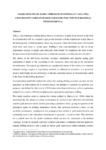VALIDATION OF GIS BASED APPROACH OF OPTIMALLY LOCATING EXPLORATION TARGETS DURING GOLD EXPLORATION IN KAKAMEGA, WESTERN KENYA
Abstract
When a new borehole is drilled during mineral exploration, it needs to be located in the field at a location that will hit a mineral target yet not interfere with the exploration budget. Due to the heterogeneity in field properties, there may be places where drill holes need to be located close from each other or further apart. Drilling is also time-dependent in that the entire exploration program is legally and technically time bound. To complicate the issue further, the placement of the borehole must also consider the decision as to direction of inclination. 1
The choice of the drill holes locations, spacings, orientations and patterns during gold exploration is based on the knowledge of the continuity, strike and dip of the subsurface mineralization. Geological, geochemical and geophysical nature of the surface environment obtained through respective exploration methods as reflected in anomalies in a particular locality individually do not sufficiently define the subsurface nature of mineralization which is the basis for the drilling decisions. 2
An exploration model that outlines the criteria for making drilling decisions has been the key deficiency in gold exploration in western Kenya. An attempt to overcome this problem was proposed and defined by Mutua et al. (2018) where data from preliminary surface exploration methods was used in a GIS based optimization approach for exploration drilling.
This study therefore seeks to validate the criteria defined by Mutua et al. (2018) where he postulated that the nature of surface environment in relation to the subsurface for Lirhanda corridor gold prospect can be used in generating a predictive model giving recognition to the geological aspect in defining mineralized blocks. His approach involved a check on the available geochemical, geophysical and geological data related to gold mineralization and correlating them to the subsurface environment to generate a consistent link. This therefore set a reliable base for the model validation which can then be performed to the defined ‘geologic’ blocks to optimize drill hole locations and hence a validated optimum model for making drilling decisions and a guide in further gold exploration within Lirhanda corridor and other similar occurrences. The research validates the reliability of remote sensing, geophysical, geochemical and geological data in identification of gold mineralization

